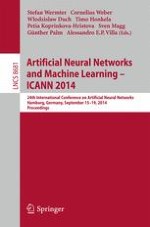2014 | Book
Artificial Neural Networks and Machine Learning – ICANN 2014
24th International Conference on Artificial Neural Networks, Hamburg, Germany, September 15-19, 2014. Proceedings
Editors: Stefan Wermter, Cornelius Weber, Włodzisław Duch, Timo Honkela, Petia Koprinkova-Hristova, Sven Magg, Günther Palm, Alessandro E. P. Villa
Publisher: Springer International Publishing
Book Series : Lecture Notes in Computer Science
